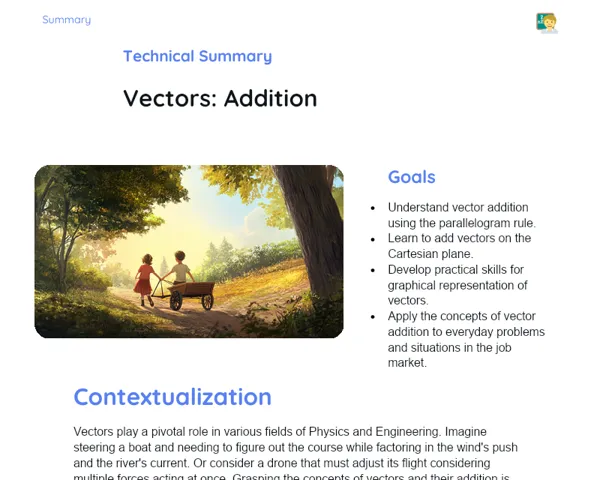Socioemotional Summary Conclusion
Goals
1. 💡 Understand the foundation of work done by an elastic force based on Hooke's Law.
2. 📐 Calculate the work done by the elastic force using the formula W=kx²/2.
3. ✨ Develop socio-emotional skills like resilience and self-control when facing challenges.
Contextualization
Think about a yo-yo that comes back to your hand after you let it go or a trampoline that bounces you back into the air. These are captivating illustrations of elastic force in action! Hooke's Law describes how the force applied to a spring or elastic material allows it to return to its original shape. This concept is crucial not just in physics but also in our ability to bounce back from life's hurdles. Let’s dive into this intriguing topic and discover its relevance to both scientific principles and our personal development.
Exercising Your Knowledge
Hooke's Law
Hooke's Law is key to understanding how materials respond to applied forces. It states that the force exerted by a spring is directly proportional to how much it is stretched or compressed from its resting point. Basically, the more you push or pull a spring, the stronger the force it will exert in trying to return to its original shape. This relationship is captured by the formula F = -kx, where 'F' is the force, 'k' is the elastic constant, and 'x' signifies the displacement.
-
Basic Formula (F = -kx): This shows the direct link between the force a spring applies and how far it is displaced.
-
Elastic Constant (k): Each spring has a unique value representing its stiffness. A higher 'k' means a stiffer spring.
-
Displacement (x): This refers to how far the spring is stretched or compressed from its neutral position. More displacement leads to a bigger force.
Work Done by an Elastic Force
The work done by an elastic force is essentially the energy needed to move an object from one position to another over the distance that the spring has been either stretched or compressed. We use the formula W = kx²/2 to calculate this energy, taking into account the elastic constant of the spring and the square of the displacement during the movement.
-
Elastic Work Formula (W = kx²/2): This helps us find out the energy that is either stored or released by a spring when it is displaced.
-
Potential Energy: This is the energy built up in the spring due to its stretching, which can be released as the spring snaps back to its equilibrium state.
-
Practical Applications: Shock absorbers in cars and various spring toys illustrate how energy is stored and brought into use.
Resilience and Self-Control
Much like a spring that regains its original position after being compressed or stretched, we can learn strategies to reclaim our emotional stability after facing challenges. Building resilience and self-control is vital for handling daily stresses, helping us to remain focused and composed in tough situations.
-
Analogies with the Spring: Just like a spring returns to balance, we can visualize our own emotional recovery journeys.
-
Resilience: The ability to rebound from difficulties and restore our sense of well-being.
-
Self-Control: Mastering our emotional reactions and keeping our cool in difficult circumstances.
Key Terms
-
Elastic Force: The force exerted by a spring when it is either compressed or stretched.
-
Hooke's Law: A principle of physics stating that the displacement of a spring aligns with the force applied to it.
-
Work: Energy transferred by a force while moving an object, calculated using the formula W = kx²/2.
-
Elastic Constant (k): A measure indicating how stiff a spring is.
-
Displacement (x): The distance a spring stretches or compresses from its neutral position.
For Reflection
-
🎢 How can the analogy of a spring returning to its original state apply to our lives when we encounter challenges and pressures?
-
🧘♂️ What strategies can you employ to regulate your emotions and maintain calm in stressful moments?
-
🔄 Recall a recent situation where you had to show resilience. How can a deeper understanding of elastic force and Hooke's Law offer fresh insights into that experience?
Important Conclusions
-
📚 The work carried out by an elastic force is elucidated by Hooke's Law, which outlines the relationship between force and displacement in springs.
-
🧮 We explored how to compute the work of the elastic force using the formula W=kx²/2, which is critical for understanding energy storage and release in spring mechanisms.
-
💪 Drawing similarities with springs enriched our understanding of resilience and self-control, which are indispensable in tackling the pressures of daily life.
Impacts on Society
The concept of elastic force plays a significant role in our daily experiences, from our mattresses and car shock absorbers to playful items like yo-yos. Gaining insight into how these forces operate deepens our appreciation for the science behind everyday objects. Such practical examples not only make physics relatable but also foster curiosity and scientific inquiry among students.
On an emotional level, the spring analogy teaches us about resilience and recovery. Just as a spring reverts to its original shape post-compression, we too can learn to regain our emotional equilibrium after facing hurdles. This perspective can inspire students to enhance their self-control and handle stress more effectively, promoting a more positive and resilient mindset.
Dealing with Emotions
To manage your emotions while delving into the topic of elastic force, here’s a practical exercise: First, recognize the emotions you experience while solving physics problems, whether they stem from frustration, excitement, or curiosity. Understand the reasons behind these emotions: Are you feeling overwhelmed due to the content or pressure of time? Name these emotions accurately, identifying them with specific terms that best describe your feelings. Express these emotions in appropriate ways, be it discussing with a peer or jotting down your thoughts in a journal. Lastly, regulate these emotions using techniques like deep breathing, taking strategic breaks, or practicing creative visualization as we’ve done in class.
Study Tips
-
🔍 Go over the concepts of Hooke's Law and the formula for elastic work (W=kx²/2) by taking comprehensive notes and practical examples.
-
📝 Engage in solving physics problems related to this topic to solidify your understanding and boost your confidence in using these formulas.
-
🤔 Link theoretical lessons with real-world situations by identifying objects that demonstrate the concept of elastic force and reflecting on their practical uses.


